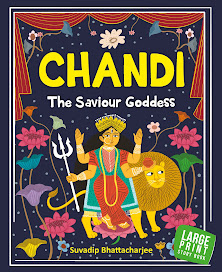Mind for Mythical Tales
Some of those storytellers, who had poetic skills, penned down the well-known stories in their own narration. As literary creators they applied their emotion, imagination and interpretation while bringing the well-known characters to life. This creative pursuit made those characters somewhat different from the original. Shri Krittibas Ojha, a 14th century poet, rewrote the entire Sanskrit Valmiki Ramayan in Bengali. Shri Kashiram Das, another Bengali poet born in 16th century, composed a bigger literary work ‒ he translated the complete Mahabharat into his mother tongue. As part of the creative process, they removed certain epic elements and added some known legends to their own version. The heroes and heroines, in their poetic verses, were given some unique features relevant to the socioeconomic structure of Bengal of that period. Thus, Ram of Valmiki and Ram of Krittibas Ojha are not exactly same. Interestingly these changes were well-received and appreciated by both commoners and royals who were the patrons of translators. The magic of storytelling and listening worked successfully.
Bengal saw a cruel political turmoil in 17th century. As the great Mughal dynasty began to fade (after the passing away of Emperor Aurangzeb), plunderers from various places tried their luck to take control of the river-clad land. They were terrific warriors and defeated the peaceful, weak people of Bengal without much defence. Bengal was massacred and the life of common people turned miserable. Helpless villagers sought the blessings of heaven for a relief from their suffering. Those appeals were heard by the poets who had a flair for writing people's restless and painful mind. They decided to pen down the stories of powerful, but local gods and goddesses who could not sit idle seeing the great misery of their admirers.
Goddess Manasa and Goddess Chandi were worshipped in certain parts of Bengal to find protection from snakebite and other threats like dacoit attacks. The talented poets looked for the fables and legends associated with these deities and penned down those stories in beautiful verses. Those were told and retold by narrators in different parts of Bengal. In each of those stories, the goddesses came down from the sky not only to help people but also to be helped by people. Divinity provided people’s safety, and humanity spread promotion of their divine power. People listened to the poems written in common man’s language, loved them, and followed them to get protection from the heaven.The stories of folk goddesses Manasa and Chandi are no new to the older generation of Bengalis. They consider them Devi which means revered divine woman, and worship them on specific days of the year. The old poetry dedicated to these goddesses are still found in the dusty shelves of century-old libraries. I was told those stories by my late grandfather Dakshina Charan (1917‒1989) who was an avid reader of mythological texts, and a narrator himself by profession. His listeners were pious elderly Hindu women who gathered at a temple to hear him reciting the religious verses and explaining to them. His daily narration to a serious audience required some practice. Hence, I, a pre-teenager, was offered the job of his rehearsing partner. His tales flowed like a speedy river, and I felt more submerged in that.
Those days with my grandfather helped me pick up a lifelong passion for the eternal tales of India. I asked him simple questions and he answered with magical mythological stories. I was intrigued by his art of storytelling like my ancestors were centuries ago. Time has changed significantly over these past three decades. Today's children, though they are ever curious about stories, do not get a chance to read those old tales that I was fortunate to hear from my grandfather. Now I have taken the seat of a modern-day storyteller. The story of the snake goddess Manasa was so popular that it was once made into a movie acted by some well-known stars. A primary-schooler, I went to watch it with my uncle. The great sorrows of widow Behula touched my tender heart. I was eager to see how she was to be helped by the powerful Manasa, who had ordered a deadly snake to take away the life of Behula’s poor husband. I was ecstatic as I saw Behula returning from the heaven as a winner with her husband beside her. She could achieve what was impossible to others. This was the story of an indomitable spirit to me.
These old tales may be of no use to the modern society that spends too much time on screens. But they help reimagine an era when people had time to listen to them, to think about them and to be happy with the end of them. What we are today is largely because what we were yesterday. Hence, these folk stories in English are rewritten for those children and elders who want to take a dive into the long gone past. I sincerely hope their endeavours will be worthwhile.
.....................................................................
Chandi: The Saviour Goddess
Manasa: The Snake Goddess
Story narrator: Suvadip Bhattacharjee
Book illustration: Papiya Saha Singha (alumnus of Kala Bhavana, Santiniketan)
Publisher: Om Books International, Delhi
Year of publication: 2024
.....................................................................
Book links on the web
Chandi: The
Saviour Goddess
Publisher: https://www.ombooksinternational.com/product/chandi-the-saviour-goddess-indian-mythology-for-children-goddess-of-india-story-book-for-kids/
Amazon: https://shorturl.at/gtzN2
Manasa: The Snake Goddess
Publisher: https://www.ombooksinternational.com/product/manasa-the-snake-goddess-indian-mythology-for-children-goddess-of-india-story-book-for-kids/






Many old memories came back
ReplyDeleteI am happy that you liked it. Old memories make us complete.
DeleteBeautiful presentation of old memories...I must read these books 😍😍
ReplyDeleteThank you so much.
Delete